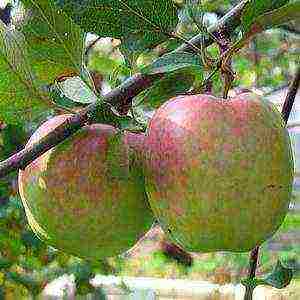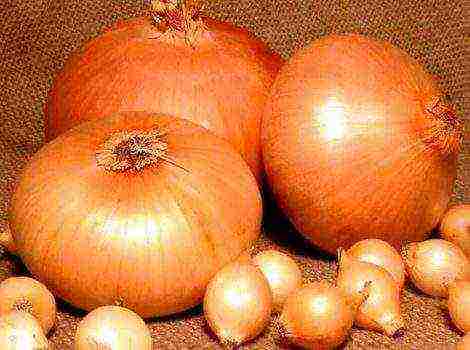Content
- 1 Tulip variety 'Gavota'
- 2 Tulip cultivar 'Recreado'
- 3 Tulip cultivar 'Olaf'
- 4 Tulip variety 'New Design'
- 5 Tulip cultivar 'Madame Spoors'
- 6 Tulip cultivar 'Happy Generation'
- 7 Tulip cultivar 'Lustige Witwe'
- 8 Tulip variety 'Alexander Puschkin'
- 9 Tulip variety 'Mascara'
- 10 Tulip cultivar 'Cancun'
- 11 Tulip variety 'Madame Curie'
- 12 Tulip variety 'Snowboard'
- 13 Tulip variety 'Grandma's fairy tales'
- 14 Tulip cultivar 'Orlenda'
- 15 Tulip 'Staning Apricot' cultivar
- 16 Tulip cultivar 'Anne Claire'
- 17 Tulip cultivar 'Preludium'
- 18 Tulip cultivar 'Tamara'
- 19 Tulip cultivar 'Emmy Peeck'
- 20 Tulip variety 'Pearl'
- 21 The nuances of tulip culture
- 22 Application
- 23 Group of early blooming tulips
- 24 Varieties, photo and name of tulips of average flowering time
- 25 Late flowering tulips: peony, simple and other classes
- 26 Specific tulips: the fourth group in the garden classification
- 27 Tulip varieties - New Dutch
- 28 Ideal for forcing varieties - Darwin hybrids and Triumph
- 29 Fringed tulips
- 30 Double tulips - early and late varieties
- 31 Low-growing tulips or dwarf
Garden-class tulips Triumph were bred at the beginning of the 20th century by crossing varieties of the Darwin hybrids and Prostnye Early classes. They are very much loved by both gardeners-breeders working with them, and summer residents who have been successfully growing for more than one year and more than one variety in their area. Triumph tulips are still proudly continuing their solemn procession, today they are the most representative garden class: their assortment makes up 25% of the entire world assortment of this flower culture.
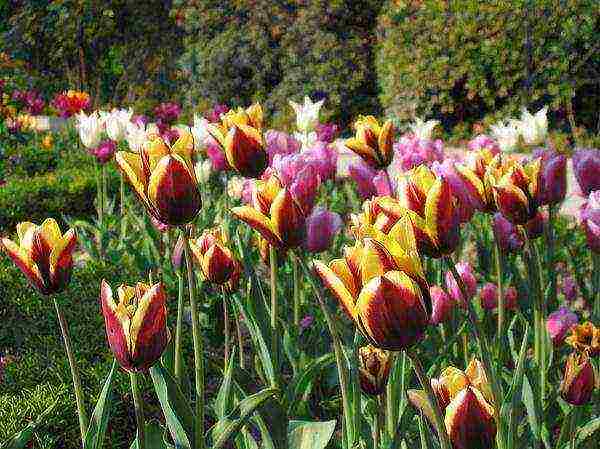
Tulips Triumph in bloom, in the foreground the variety Gavota
Tulips of this class are characterized by large goblet flowers, rather tall (40-70 cm) strong peduncles and a good reproductive rate. The color of the flowers is very diverse: from pure white to dark purple. They bloom for quite a long time, starting from mid-April - early May, they keep the shape of the glass well.
Tulip variety 'Gavota'
A bicolor variety created in 1961.

Tulip Gavota cultivar Plant up to 40 cm high, sturdy stem. Cup-shaped flower up to 8 cm high, purple-brown, with a light yellow border along the edge of pointed petals; blooms * from the second decade of April and blooms for 10 days. Resistant to diseases and adverse environmental factors, can be affected by the variegated virus. Effective in the foreground of flower beds, suitable for forcing from January to March inclusive.
Tulip cultivar 'Recreado'
A mysterious strain created by Visser in 1979.
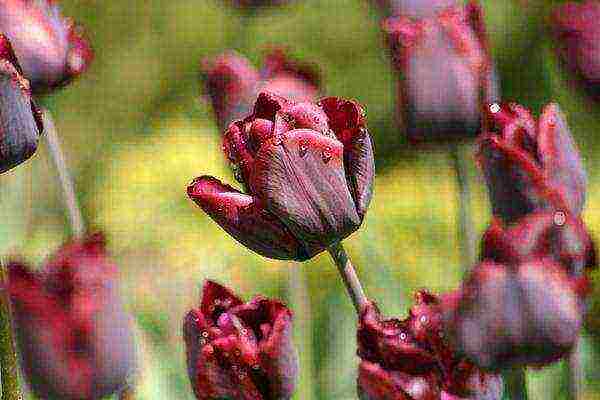
Tulip Recreado cultivar, photo by A. Papkov Plant 30 cm high, sturdy flower stalk. The flower is goblet, up to 8 cm high, dark purple. It blooms in 2-3 decades of April, duration - up to 10 days. Resistant to unfavorable weather conditions, can be affected by fusarium and variegation virus. Suitable for spring flower beds, which brings mystery and sophistication. Well worth the cut.
Tulip cultivar 'Olaf'
This ruby red tulip was created in 1930.
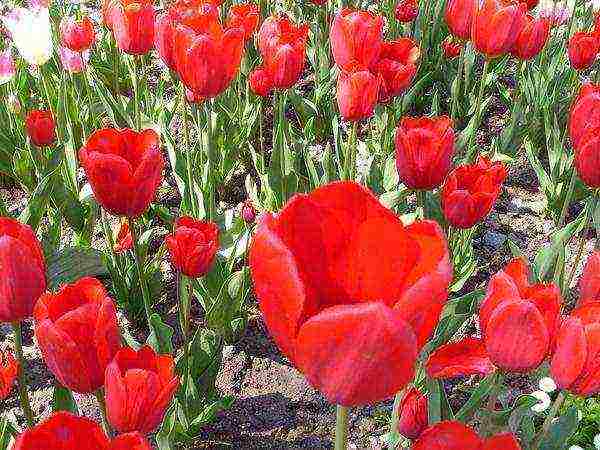
Tulip Olaf grade It is low - up to 30 cm; the goblet flower is large, up to 9 cm high. It begins its bright flowering from the second decade of April, flowering lasts up to 20 days. Resistant, but can be affected by variegation virus and fusarium.
Tulip variety 'New Design'
A very effective variegated variety bred by Toll in 1974.

Tulip cultivar New Design The tulip is not very tall (about 20-30 cm), the stem is strong, the edges of the leaves are bordered by a pink-white stripe. The flower is goblet, up to 9 cm high, white, with a wide pink border along the edge of the petals. It blooms from the 3rd decade of April, not for long (up to 10 days). Resistant to diseases and adverse weather conditions. Interesting in the foreground of spring mixborders, suitable for cutting and early spring (in March) forcing.
Tulip cultivar 'Madame Spoors'
Those who love variegated tulips (not to be confused with variegated tulips) should definitely take a look at this strain, created by Sandberger in 1985.
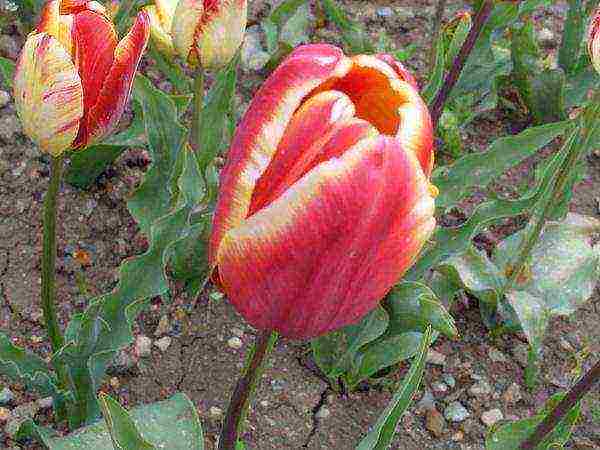
Tulip grade Madame Spoors Grade 45 cm high, sturdy stem. The flower is goblet, up to 9 cm high, dark crimson red, with a light yellow stripe along the edge of the petals. It blooms for 10 days, starting from the 2nd decade of April. Resistant to diseases and adverse weather conditions. Good for cutting and winter-spring forcing (from January to March inclusive).
Tulip cultivar 'Happy Generation'
An exquisite variety bred in 1969.

Tulip cultivar Happy Generation, photo A. Papkov Plant 50 cm high, strong stem, goblet flower, up to 9 cm high, white, with a crimson stripe in the center of the petals. It blooms from the 3rd decade of April (flowering duration up to 10 days). Resistant to unfavorable weather conditions, diseases and pests (in some years it is affected by Fusarium and variegation virus). Good in spring flower beds, flower beds; it is impossible to pass by this variety without stopping for a minute to admire the interesting lines of the pattern on the petals. Suitable for cutting, forcing (from January to March inclusive).
Tulip cultivar 'Lustige Witwe'
The variety was created by A. May during the Great Patriotic War (in 1942).
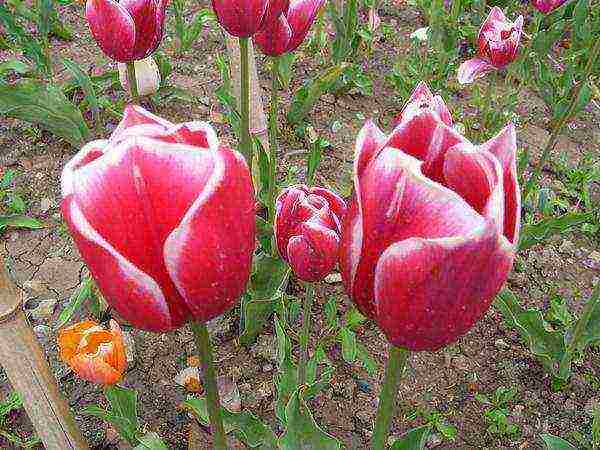
Tulip cultivar Lustige Witwe Strong stem 40-50 cm high, flower up to 8 cm high, cupped, dark crimson, with a white stripe along the edge of pointed petals. It blooms from the 2nd decade of April for 2 weeks. Resistant to weather surprises and diseases, but can be attacked by the variegated virus.
Tulip variety 'Alexander Puschkin'
Similar to the previous variety, a novelty of Dutch breeding. It has already been presented on the site earlier.
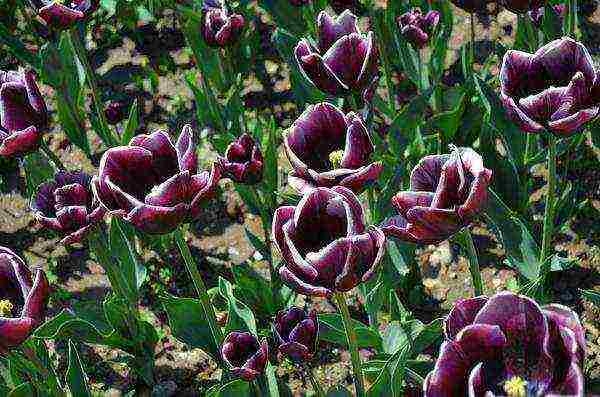
Tulip Alexander Puschkin cultivar Plant 40-45 cm high, sturdy stem, large flower, up to 8 cm high, maroon-purple, with a white border along the edge of the petals. Bloom more than 2 weeks. A very spectacular variety that will find its place in spring flower beds; suitable for forcing from January to March.
Tulip variety 'Mascara'
A luxurious variety - a novelty of the Dutch selection.

Tulip cultivar Mascara Plant 45-55 cm high, sturdy peduncle, goblet flower, up to 8 cm high, dark red. It blooms from the 3rd decade of April for 10 days. Resistant to adverse weather conditions. Good in flower gardens, where it creates bright spots in the spring; suitable for cutting and forcing in the winter-spring period (February-March).
Tulip cultivar 'Cancun'
A very beautiful variety.

Tulip Cancun cultivar Stem up to 60 cm high, strong. The goblet flower is large (up to 9 cm high), yellow, with a gradual transition to red. Resistant to winds and other weather troubles. It blooms from the 2nd decade of May. Good in mixborders, borders; stands perfectly in the cut.
Tulip cultivar 'Madame Curie'
This variety was created by the famous breeder Lefeber in 1944.

Tulip Madame Curie cultivar The cultivar is medium-sized, 50 cm high, the stem is strong. The flower is goblet, with pointed petals, up to 8 cm high, dark crimson. Dissolves from the 2nd decade of April; flowering up to 10 days. Resistant to diseases and adverse weather conditions.
Tulip variety 'Snowboard'
An exquisite variety with a strong peduncle up to 55 cm high.
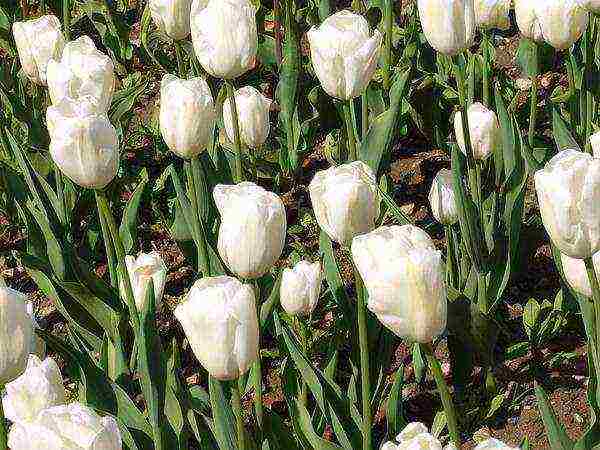
Tulip Snowboard The flower is white, goblet, up to 6 cm high. It blooms in early May. You cannot do without such varieties when creating a white garden.
Tulip variety 'Grandma's fairy tales'
A domestic variety bred in Crimea by L.M. Alexandrova.
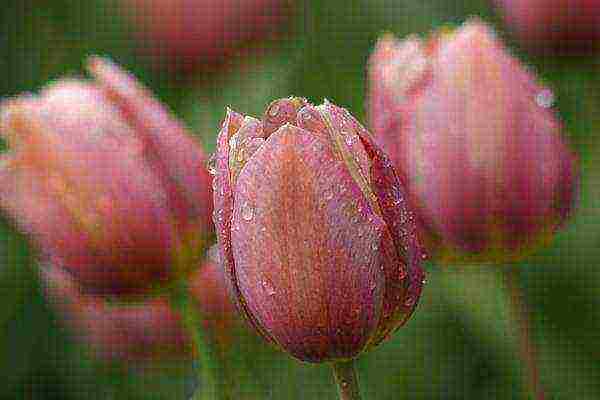
Tulip variety Granny's fairy tales, photo by A. Papkov Plant 50 cm high with a strong stem. The flower is goblet, up to 9 cm high, indescribable by the words of the color "faded grandmother's sundress". Blooms from 2-3 decades of April for 2 weeks. It tolerates well the high temperatures of the soil and dry winds that occur during the flowering period of plants, but in especially hot years, the duration of flowering can be reduced by 2-4 days. Resistant to diseases and pests, to adverse weather conditions. Self-sufficient in spring compositions, good in combination with tulip varieties and other spring-flowering bulbs. Suitable for cutting.
Tulip cultivar 'Orlenda'
This variety is a novelty of Dutch breeding. They predict a brilliant future for him, as they are considered one of the most promising.
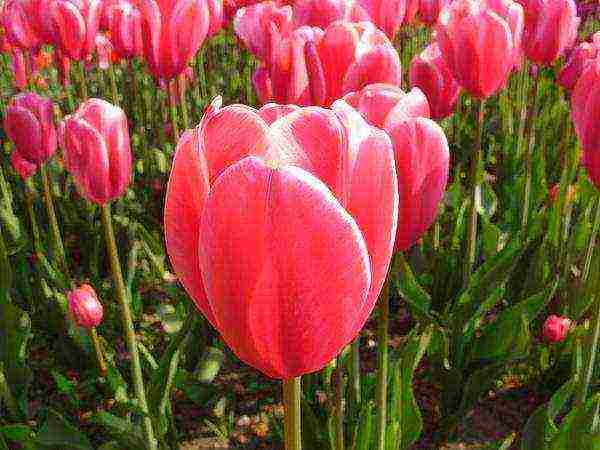
Tulip Orlenda cultivar Durable, up to 60 cm high.The flower is bright crimson, with a narrow white border along the edge of the petals. Good for forcing from February to March, well worth cutting.
Tulip 'Staning Apricot' cultivar
A popular cultivar with a strong peduncle about 40 cm high.

Tulip Staning Apricot, photo by A. Papkov The flower is pink in the center of the petal, and apricot at the edges. A very effective variety! He is simply gorgeous in spring flower beds, borders; it can be grown in containers.
Tulip cultivar 'Anne Claire'
An excellent old-fashioned variety created by Coleen in 1958.
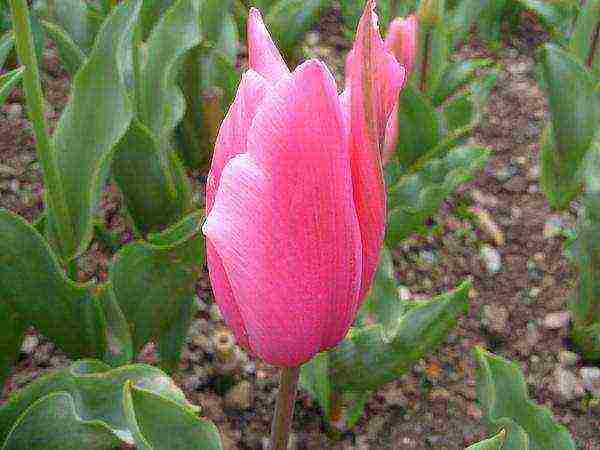
Tulip grade Anne Claire Plant 40-50 cm high; the peduncle is strong, the flower is goblet, up to 9 cm high, red-violet, with light lilac edges of the petals. It blooms in the 2-3 decade of April; duration - up to 10 days. Resistant to adverse weather conditions; can be affected by the variegated virus. Beautiful in spring in a wide variety of flower arrangements, suitable for cutting.
Tulip cultivar 'Preludium'
This variety was created by Koolen in the last year of the Great Patriotic War (1945).
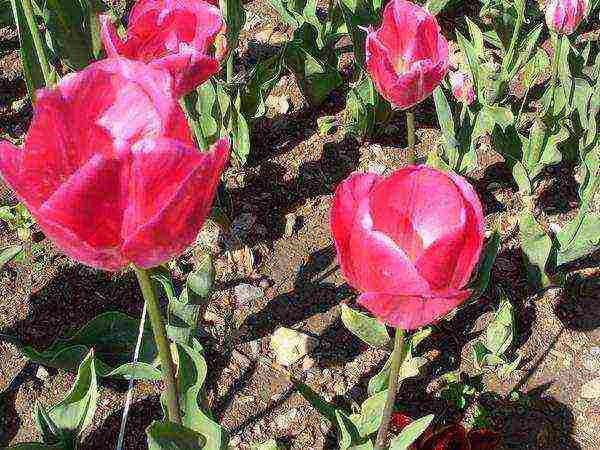
Tulip variety Preludium The stem is strong, 45 cm high. The flower is cup-shaped, large (up to 9 cm high), light pink, along the edge of the petal there is a wide lilac-pink stripe. Blooms from 2-3 decades of April, duration - up to 12 days. Resistant to diseases, but can be affected by the variegated virus; well resists weather whims. Suitable for cutting and forcing from January to March.
Tulip cultivar 'Tamara'
A very fashionable now white and red variety, created by Visser in 1979.

Tulip variety Tamara It is 40-50 cm high. The flower is goblet, large, up to 9 cm high, white, with a wide carmine-red strip along the edge of the petals. Blooms from 2-3 decades of April, flowering duration up to 12 days. Resistant to diseases and weather troubles. Good for cutting and forcing (January to March).
Tulip cultivar 'Emmy Peeck'
Historic variety created by Hybrida in 1949.
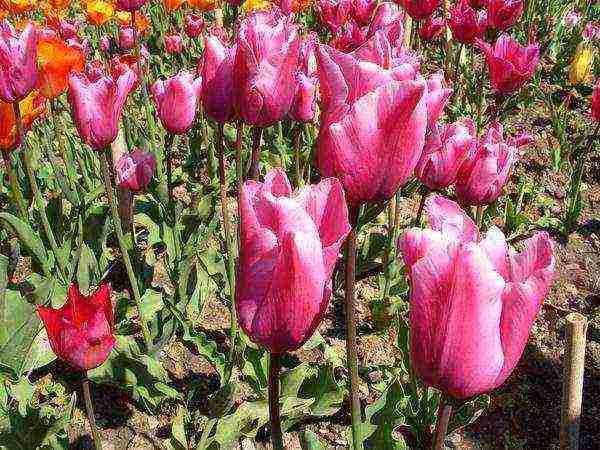
Tulip sort Emmy Peeck Plant 50 cm high. The flower is broadly goblet, large (up to 9 cm high), dark lilac-pink, with lighter edges of the petals. Flowering from the 3rd decade of April, lasting up to 17 days. May be affected by the variegated virus; resistant to bad weather. Good for cutting and in spring flower beds.
Tulip variety 'Pearl'
The domestic variety was created in the Crimea, co-author L.M. Alexandrova.
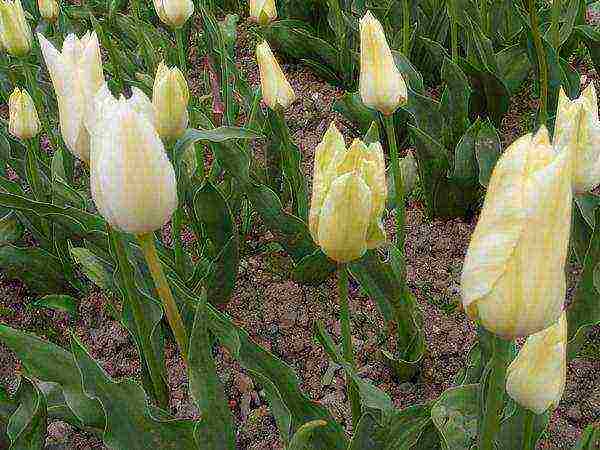
Tulip Pearl grade Stem strong, up to 50 cm high. Goblet flower, 6-8 cm high, white-cream. Blooms from 2-3 decades of April for 2 weeks.
The nuances of tulip culture
- To prevent tulips from becoming smaller, they should be dug up annually.
- It is advisable to dig up the bulbs when the leaves turn yellow. Depending on the flowering period of various varieties, this is the second half of May or mid-June (in Crimea).
- After digging, the bulbs are dried in the shade, in a well-ventilated place, they are cleaned of old mother scales, the new crop is sorted by size and set for storage.
- To avoid the spread of diseases, the bulbs are treated with fungicides; it is useful to sprinkle them with colloidal sulfur.
- During storage, it is very important to observe the temperature regime, which regulates the passage of all organ-forming processes in the bulbs, determining the future flowering and the quality of new bulbs.
- Storage temperature should not exceed + 25 ° С.
Application
Tulips Triumph are good in the spring decoration of the local area, summer cottage, in various mixborders, on flower beds. Suitable for winter-spring forcing (from January to March inclusive) and for cutting.
* Blossoming dates are for the southern regions.
 Tulips have long been the subject of admiration in the East, once in Europe, they caused a real flurry of passions, becoming one of the most beloved and widespread garden plants. Today, tulip varieties are at the disposal of flower growers, the photos and names of which will certainly cause a desire to decorate their plot with these flowers.
Tulips have long been the subject of admiration in the East, once in Europe, they caused a real flurry of passions, becoming one of the most beloved and widespread garden plants. Today, tulip varieties are at the disposal of flower growers, the photos and names of which will certainly cause a desire to decorate their plot with these flowers.
The huge number of wild and cultivated varieties forced botanists and tulip connoisseurs to create and constantly improve a special classification, which includes several classes and groups.
The Netherlands has historically been the world center for tulip breeding.Having come here many centuries ago, the bulbous culture has become the love and work of life of entire dynasties. Therefore, both proven old and incredibly spectacular new Dutch tulips are still the basis of every collection.
According to the flowering period, plants are divided into early, middle and late. By flower shape and origin, tulips are divided into fifteen classes, most of which are given to Gesner and Foster tulip hybrids.
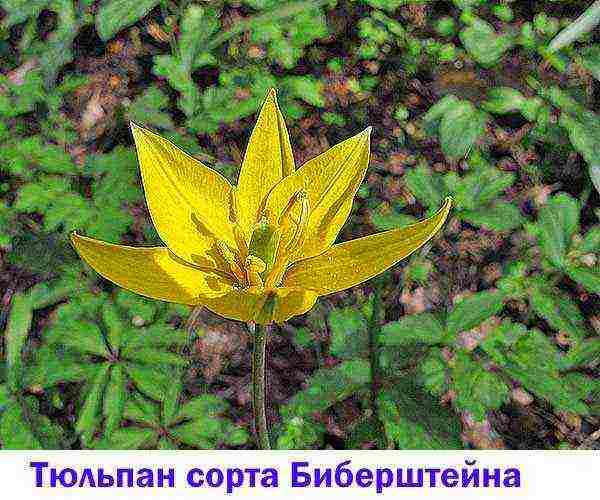 Since even wild species are decorative, such as the Bieberstein tulip, a separate class is also devoted to them. Species plants, on which breeders are actively working, also have their own sections. These are the tulips of Kaufman, Foster and Greig.
Since even wild species are decorative, such as the Bieberstein tulip, a separate class is also devoted to them. Species plants, on which breeders are actively working, also have their own sections. These are the tulips of Kaufman, Foster and Greig.
Group of early blooming tulips
Photos of tulips and the names of varieties of early flowering periods always arouse keen interest in flower growers. This is not surprising, because in the first warm days, you so want bright colors. Among the spring bulbs, tulips have the largest flowers. However, the early varieties of simple and double tulips are inferior in height and variety to their later counterparts.
 Simple early tulips or Tulipa single early are grouped into Class 1. Plants up to 40 cm in height with relatively small corollas belong to the Gesner and Schrenck tulips. Depending on the variety, the size of a glass-like flower reaches 5–7 cm. The color of flowers is dominated by red and yellow tones. Although there are more original colors, for example, the delicate purple tulip of the Purple Prince variety shown in the photo.
Simple early tulips or Tulipa single early are grouped into Class 1. Plants up to 40 cm in height with relatively small corollas belong to the Gesner and Schrenck tulips. Depending on the variety, the size of a glass-like flower reaches 5–7 cm. The color of flowers is dominated by red and yellow tones. Although there are more original colors, for example, the delicate purple tulip of the Purple Prince variety shown in the photo.
 Recently, the popularity of early varieties of tulips blooming since mid-April has been growing, which is facilitated by the possibility of forcing flowers, but strong, but short flower stalks are not always suitable for cutting.
Recently, the popularity of early varieties of tulips blooming since mid-April has been growing, which is facilitated by the possibility of forcing flowers, but strong, but short flower stalks are not always suitable for cutting.
 Forming Class 2 Tulipa Double Early early double tulips were first obtained shortly after the emergence of the culture in the Old World. The English name of the group literally translates as "double", which accurately describes the structure of the flower, as if consisting of two nested corollas.
Forming Class 2 Tulipa Double Early early double tulips were first obtained shortly after the emergence of the culture in the Old World. The English name of the group literally translates as "double", which accurately describes the structure of the flower, as if consisting of two nested corollas.
Today, breeders offer flower growers to grow incredibly lush flowers with additional petals. Plants of this type are short, sturdy, bloom for up to two weeks and are excellent for growing in pots, as well as for spring forcing.
Varieties, photo and name of tulips of average flowering time
The second group of plants combines the most common and popular tulips of Darwin and Triumph.
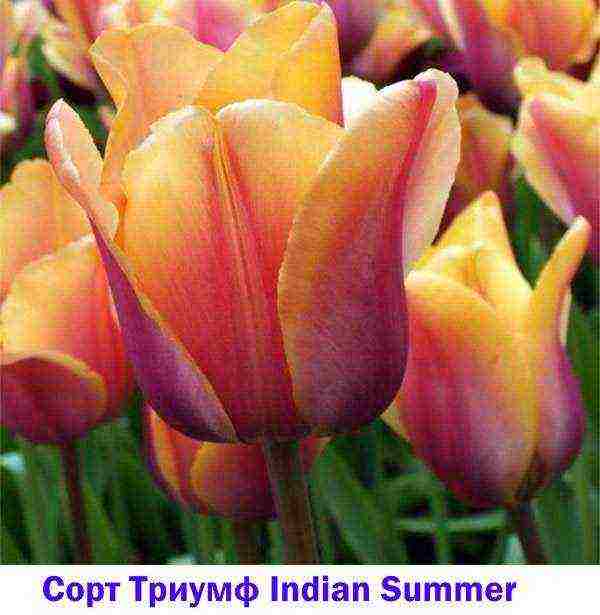 Included in Class 3, Triumph tulips are a composite group of plants with simple large flowers crowning flower stalks up to 70 cm in height. Varieties dating back to the beginning of the last century and new varieties are excellent for mass cultivation. Growers are attracted by the strong flower stalks of tulips and perfectly shape-retaining flowers, shaped like graceful wine glasses. Flowering begins in the last decade of April and lasts 7-12 days.
Included in Class 3, Triumph tulips are a composite group of plants with simple large flowers crowning flower stalks up to 70 cm in height. Varieties dating back to the beginning of the last century and new varieties are excellent for mass cultivation. Growers are attracted by the strong flower stalks of tulips and perfectly shape-retaining flowers, shaped like graceful wine glasses. Flowering begins in the last decade of April and lasts 7-12 days.
 Due to their size, stable flowering and the presence of not only red, but also yellow, pink tulips, plants with white, deep purple and even two-color corollas, mid-early varieties are recognized by landscape designers, ordinary flower growers and those who are partial to tulips in bouquets. The interest of summer residents in the group is supported by:
Due to their size, stable flowering and the presence of not only red, but also yellow, pink tulips, plants with white, deep purple and even two-color corollas, mid-early varieties are recognized by landscape designers, ordinary flower growers and those who are partial to tulips in bouquets. The interest of summer residents in the group is supported by:
- unpretentiousness of varieties;
- versatility of appointment;
- an abundance of colors;
- large flowers that keep their shape and freshness for a long time;
- easy vegetative propagation;
- the ability to use for forcing in the middle and late periods.
Tall, resistant to viral diseases and highly variable due to their tendency to mutation, Darwin's hybrids compete equally with the Triumph tulips and form Class 4, as extensive as the previous one.
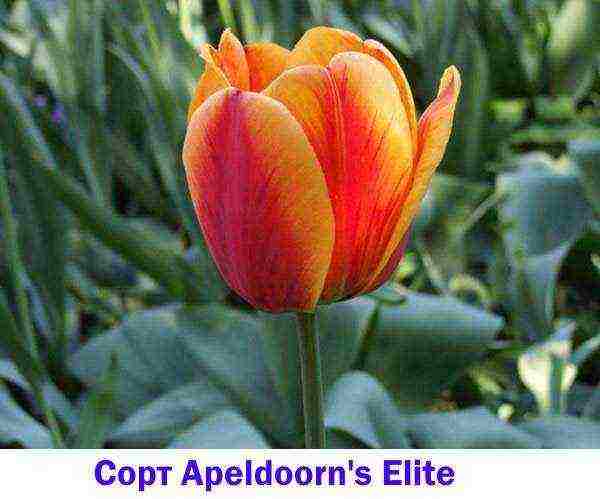 These plants owe their popularity to the tulip variety shown in the photo with the name Apeldoorn, which fully demonstrated the ability to produce offspring during vegetative propagation, unlike the parent plants.
These plants owe their popularity to the tulip variety shown in the photo with the name Apeldoorn, which fully demonstrated the ability to produce offspring during vegetative propagation, unlike the parent plants.
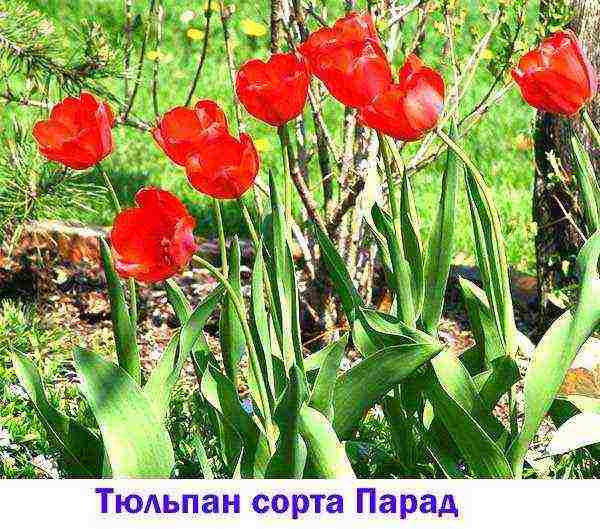 Another variety widely known in the territory of the former Soviet Union is the Parade tulip, obtained back in the 50s and still decorating the streets of Russian cities and flower beds of summer residents.
Another variety widely known in the territory of the former Soviet Union is the Parade tulip, obtained back in the 50s and still decorating the streets of Russian cities and flower beds of summer residents.
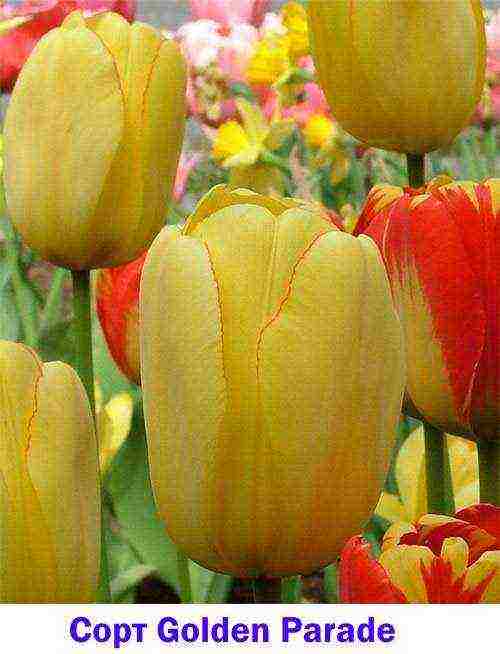 The yellow tulip shown in the photo, closely related to the previous variety, is called Golden Parade and is rightfully considered one of the largest mid-early varieties in the family.
The yellow tulip shown in the photo, closely related to the previous variety, is called Golden Parade and is rightfully considered one of the largest mid-early varieties in the family.
All Darwin hybrids are more often characterized by red or two-color coloration of large corollas, about 10 cm in height. Flowers in sunny weather can fully open, which speeds up their fall.
Late flowering tulips: peony, simple and other classes
This group is the most extensive and variegated, both in color and in the shape of the corollas, the flowers combined into it. Tulips form seven independent classes, some of which are actively developing, and some will soon become history.
 Class 5 includes cultivars of late simple tulips or Tulipa Single Late with flower stalks up to 75 cm high and egg-shaped corollas. The petals of these tulips are rounded, and the bottom of the flower forms an almost regular square. This class is incredibly diverse. Any colors and their combinations are possible here.
Class 5 includes cultivars of late simple tulips or Tulipa Single Late with flower stalks up to 75 cm high and egg-shaped corollas. The petals of these tulips are rounded, and the bottom of the flower forms an almost regular square. This class is incredibly diverse. Any colors and their combinations are possible here.
White and black tulips look very impressive next to them, which in the photo are represented by the Queen of Night variety. The varieties blooming in mid-May are excellent in the flowerbed and in the cut, but they are not suitable for forcing, since they have been dormant for too long.
The extraordinarily graceful tulips Tulipa Lilyflowering form Class 6.
 These plants are from Turkey, due to their low endurance, spread in Europe relatively recently. The main feature of the representatives of the class is the pointed petals, which form a refined, lily-like corolla. The height of the peduncles is 50 - 60 cm.
These plants are from Turkey, due to their low endurance, spread in Europe relatively recently. The main feature of the representatives of the class is the pointed petals, which form a refined, lily-like corolla. The height of the peduncles is 50 - 60 cm.
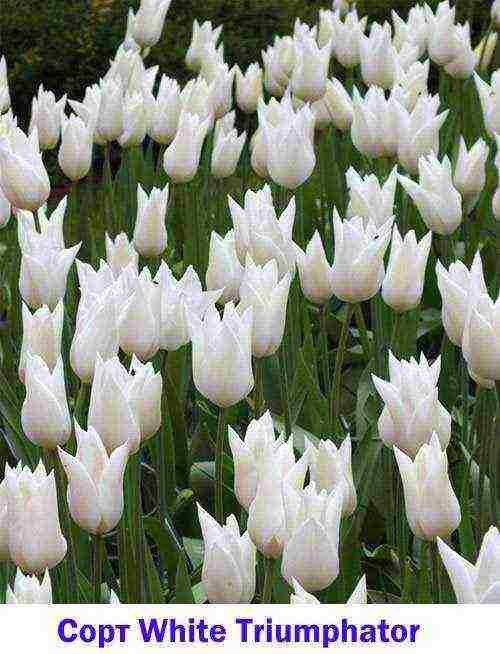 In the palette of lily-colored tulips, white, as in the photo, pink, lilac, yellow and red tones, as well as their numerous combinations.
In the palette of lily-colored tulips, white, as in the photo, pink, lilac, yellow and red tones, as well as their numerous combinations.
In Class 7, flowers of all shapes can be seen, from simple to lily or terry.
 However, all varieties will have one common feature - the presence of a needle-like fringe on the edges of the petals. The first flowers of this variety were seen in the first half of the last century, and since then, unusual varieties for cutting and landscape decoration appear more and more often.
However, all varieties will have one common feature - the presence of a needle-like fringe on the edges of the petals. The first flowers of this variety were seen in the first half of the last century, and since then, unusual varieties for cutting and landscape decoration appear more and more often.
 One of the newest sections of the garden classification - Class 8 is formed by the green tulips Tulipa Viridiflora, obtained from the fixed mutation of simple plants.
One of the newest sections of the garden classification - Class 8 is formed by the green tulips Tulipa Viridiflora, obtained from the fixed mutation of simple plants.
 You can distinguish it from your fellows by a wide green stripe running along the central lily of each petal. Because of it, tulip buds look green for a long time, and their true color appears only at the stage of dissolution. The white tulip of the Spring Green variety shown in the photo is the most popular in the class.
You can distinguish it from your fellows by a wide green stripe running along the central lily of each petal. Because of it, tulip buds look green for a long time, and their true color appears only at the stage of dissolution. The white tulip of the Spring Green variety shown in the photo is the most popular in the class.
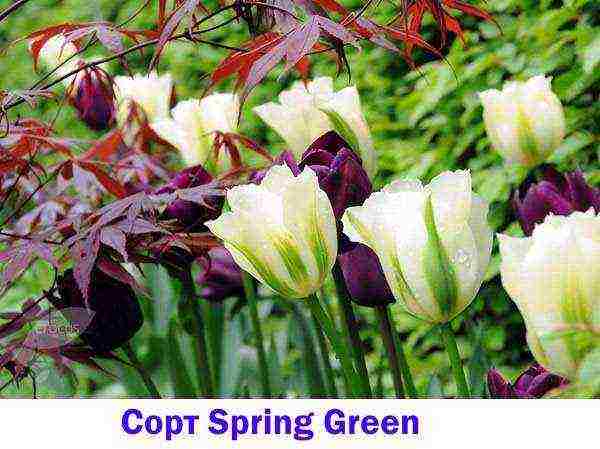 The medium and large height of the peduncles made tulips of this class available both for decorating the site and for cutting.
The medium and large height of the peduncles made tulips of this class available both for decorating the site and for cutting.
If the eighth class is new, then the class 9, intended for Rembrandt variegated tulips, has no development prospects. This community of varieties, well known from the paintings of Dutch and Flemish painters of the 17th – 18th centuries, is today actually abolished, and the varieties remaining after the reorganization of the class have been transferred to other groups.
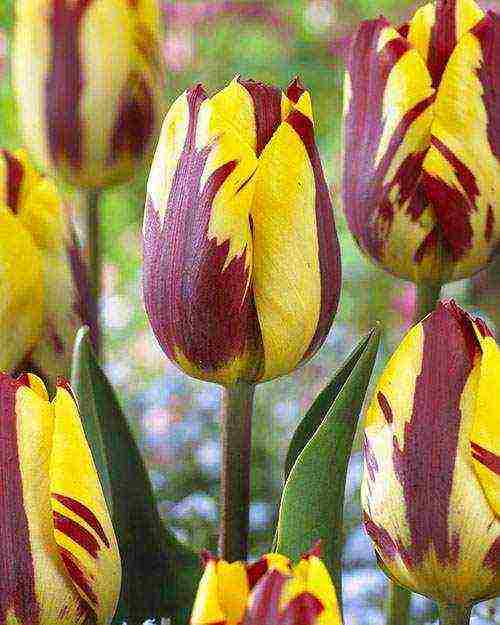 The reason for this is the fixation of a dangerous variegation virus in the plant, which causes the appearance of stripes and strokes of contrasting shades on the petals.
The reason for this is the fixation of a dangerous variegation virus in the plant, which causes the appearance of stripes and strokes of contrasting shades on the petals.
 Parrot tulips with fancy petals reminiscent of exotic bird feathers form Class 10. Plants of this variety are distinguished not only by their bizarre corolla shapes, but also by their size.
Parrot tulips with fancy petals reminiscent of exotic bird feathers form Class 10. Plants of this variety are distinguished not only by their bizarre corolla shapes, but also by their size.
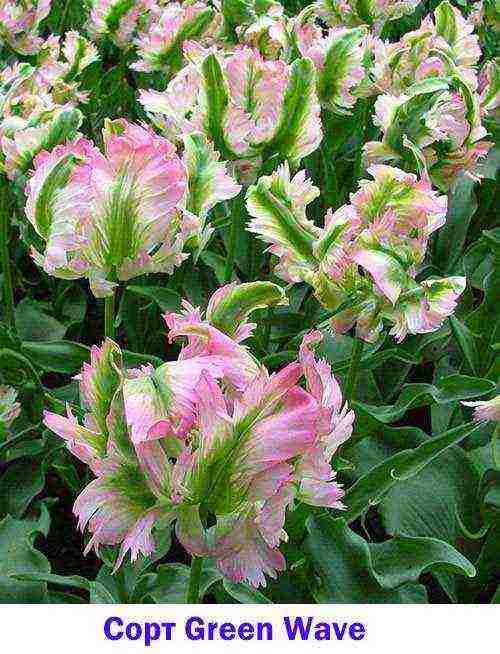 The diameter of the flower can be up to 20 cm, which imposes its own requirements on the strength of the peduncles. The stems of parrot tulips are really strong, but not too tall, growing up to 40-60 cm. In order to prevent loss of flowers due to wind or heavy rain, plants are provided with reliable protection, and sometimes support.
The diameter of the flower can be up to 20 cm, which imposes its own requirements on the strength of the peduncles. The stems of parrot tulips are really strong, but not too tall, growing up to 40-60 cm. In order to prevent loss of flowers due to wind or heavy rain, plants are provided with reliable protection, and sometimes support.
 Double late tulips forming Class 11 are called Tulipa Double Late by analogy with the early ones. However, this group has another name, caused by the beautiful shape of a large flower - peony tulips.
Double late tulips forming Class 11 are called Tulipa Double Late by analogy with the early ones. However, this group has another name, caused by the beautiful shape of a large flower - peony tulips.
 Compared to the double flowers that open in late April, late varieties have much thicker corollas, such as the descendant of the Apeldoorn tulip, double Beauty Of Apeldoorn.
Compared to the double flowers that open in late April, late varieties have much thicker corollas, such as the descendant of the Apeldoorn tulip, double Beauty Of Apeldoorn.
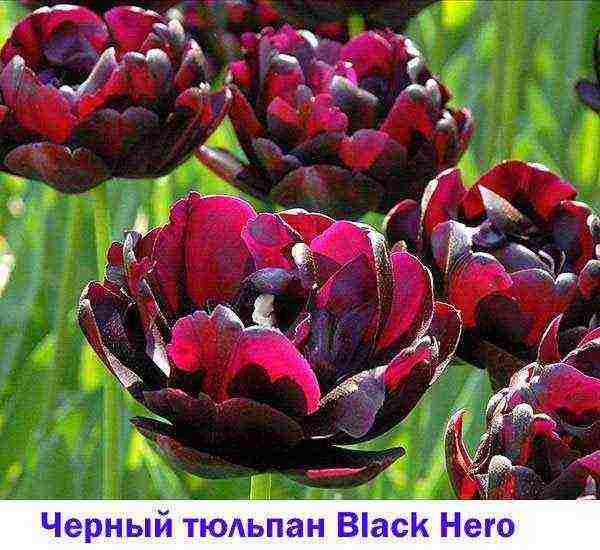 Like parrot tulips, late terry varieties with heavy heads need support and planting in a place protected from the wind.With regular care and attention, these plants with stems up to 60 cm will create a carpet of incredible beauty and brightness on a flower bed.
Like parrot tulips, late terry varieties with heavy heads need support and planting in a place protected from the wind.With regular care and attention, these plants with stems up to 60 cm will create a carpet of incredible beauty and brightness on a flower bed.
 Recently, special attention of flower growers has been given to the Ice Cream tulip with superficial petals of a juicy berry shade and a snow-white core, reminiscent of a horn with a favorite summer delicacy. Although the variety is relatively new, a photo of the tulip Ice cream today adorns not only the catalogs of bulb growers, but also the sites of Russian summer residents.
Recently, special attention of flower growers has been given to the Ice Cream tulip with superficial petals of a juicy berry shade and a snow-white core, reminiscent of a horn with a favorite summer delicacy. Although the variety is relatively new, a photo of the tulip Ice cream today adorns not only the catalogs of bulb growers, but also the sites of Russian summer residents.
Specific tulips: the fourth group in the garden classification
The fourth group is the specific tulips used in the breeding of cultivated varieties and grown as independent ornamental plants.
 Class 12 is given to Kaufman tulips, which bloom in March, can reach a height of 30 cm, and their flowers with pointed petals of different colors are always organic on low borders and rocky hills.
Class 12 is given to Kaufman tulips, which bloom in March, can reach a height of 30 cm, and their flowers with pointed petals of different colors are always organic on low borders and rocky hills.
Foster's tulips, the tallest of the species, are distinguished not only by this, but also by their large flowers, which made it possible to use the plants to obtain many modern varieties belonging to other groups and classes. Foster's tulip buds open in April and immediately draw attention to themselves with the unusual petals bent at the top.
 The specific Greig tulips and their hybrids forming Class 14 are easily distinguished by their patterned leaves covered with colored stripes and strokes. Although plants of this species are not distinguished by high growth, due to their high decorativeness and long flowering, they are always welcome guests on the site.
The specific Greig tulips and their hybrids forming Class 14 are easily distinguished by their patterned leaves covered with colored stripes and strokes. Although plants of this species are not distinguished by high growth, due to their high decorativeness and long flowering, they are always welcome guests on the site.
Class 15 contains wild species tulips. Compared to their garden descendants and relatives, these species, often called botanical, are shorter, better adapted to harsh conditions. In addition, small flowers full of charm are less affected by diseases or completely resistant to them.
Video about tulip varieties
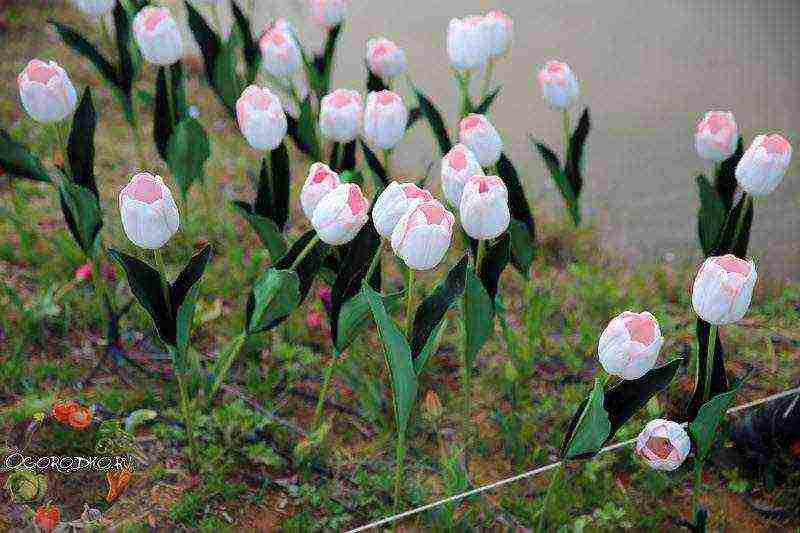
It is impossible to enumerate tulip varieties, there are an incredible variety of them - double late, fringed, undersized, peony, Dutch, for forcing and growing in a greenhouse - each of them will delight with their flowering, if the plant is properly cared for ...
Tulip varieties - New Dutch
![]() The tulip has long become a symbol of Holland - every year breeders present fresh varieties of Dutch tulips, although more than 2.5 thousand of them have already been bred in the Netherlands alone, and experienced gardeners have already got acquainted with the latest novelties:
The tulip has long become a symbol of Holland - every year breeders present fresh varieties of Dutch tulips, although more than 2.5 thousand of them have already been bred in the Netherlands alone, and experienced gardeners have already got acquainted with the latest novelties:
 |
Albatross - snow-white, with a large graceful head, strong stem and dense leaves; |
 |
Beauty Trend - goblet, white, with a pink border, the stem reaches 70 cm; |
 |
Casharel - intense pink glass with fringed edges; |
 |
Verandi - harmoniously combines tomato red and sunny yellow tones with sharp transitions, the stem grows up to 55 cm. |
Ideal for forcing varieties - Darwin hybrids and Triumph
Tulips can bloom not only in spring, but in any month for the holiday, if they are grown according to the rules in a greenhouse or even at home - this method of growing is called forcing, and only special varieties of tulips can be successfully grown in this way.

tulips for distillation
For distillation, medium-flowering plants are optimal, first of all, of two classes - Darwin hybrids and Triumph:
Representatives of Darwin hybrids - goblet, impressive in size, with a diameter of more than 10 cm, on an 80-centimeter leg, - they open wide in the sun, like poppies, usually in red tones, but there are also two-color specimens;
Tulips Triumph have a goblet flower shape, can reach a height of 80 cm, as for color schemes, all colors and shades are present in the color palette of this class of tulips, with the exception of blue.
It is also worth highlighting the varieties of tulips for forcing in the greenhouse:
- Diplomat - bright pink with a blue-white center, the stem reaches 50-60 cm;
- Vivex - large reddish-orange with yellow edges, elongated bud with a strong peduncle that does not open in the light;
Traditionally used for forcing tulip varieties Parade, Keys Nelis, Eric Hofsier.
Fringed tulips
Fringed tulips, the varieties and varieties of which appeared in Holland in the 30s of the XX century, got their name for the needle-like outgrowths along the edges of the petals, forming a fringe - they resembled a predatory plant sundew, this is how the name Sandyu is translated - the very first variety of this class, but recently, their multi-flowered varieties have also appeared:
Varieties of some fringed tulips are similar to lily-colored ones, in which three triangular inner petals are combined with reed outer ones - these are canary yellow Laverok, lemon Hamilton and others.
Double tulips - early and late varieties
Terry varieties are early and late. Early double tulips are undersized, their height does not exceed 30 cm, bloom at the end of April and delight the eye for a long time - they are planted in containers, they are excellent for forcing:
Late double tulips keep you waiting - they begin to bloom only in the second half of May. They are called pion-shaped, as they are sometimes indistinguishable from peonies - these luxurious creatures serve as a precious decoration of flower beds.
Terry late varieties show a variety of colors - from snowy white to very dark, there are also extremely expressive two-tone varieties. All of them look great on the alleys of parks and in gardens:
Spectacular varieties of this class are Virosa, Charmin Lady, Sunlaver, Black Hirow, Negritta Double, Blue Diamond, Orange Angelica, Ankle Tom Bonanza.
White peony tulips look especially airy - these are Mount Tacoma, Casablanca, Maureen Double, Denslane.
Low-growing tulips or dwarf
Dwarf varieties are distinguished by unprecedented endurance, they are not afraid of cold weather, drought, wind, they are the first to decorate flower beds, they can also be used for forcing. Dwarfs, whose height is no more than 10 cm, are varied in color - from pure white to dark purple, but they are especially striking in the variety of purple tones, among them there are pink, bright crimson, purple, carmine, cherry.
Low-growing tulips are diverse in shape - they can be double, lily-shaped, multi-flowered, and among the best varieties are:
Tulip varieties such as Rembrandt tulips, as if stained by the artist's brush, will become real treasures of your garden:
The world collection of varieties is constantly growing, and flowers are becoming more and more like works of art.
A little more and the gray winter sky will change its color to a more joyful one - spring blue. And this means that it is time to present all the bright colors of your garden now. Those who did not manage to plant bulbous plants in autumn can do it now. This article will tell you about your favorite bulbs like tulips. More precisely, we offer 6 varieties - favorites for decorating the spring look of the site. They belong to different groups.
Cash - a tulip variety from the group of Darwin hybrids. The flower is yellow with red strokes. The dimensions of the Cash Tulip flower are 6 cm in height and 4 cm in diameter. The plant itself grows up to 65 cm. The tulip begins to bloom from late April - early May. The bulb produces many babies - accordingly, the plant reproduces well. This tulip variety is recommended for distillation in February-March in bouquets. It tolerates spring frosts well, is resistant to the variegated petal virus and retains its attractiveness in a vase for a long time. It smells very nice and rich. Similar varieties Crossfire, Striped Bellona, Andre Citroen, Falcon, Hennie van de Most, Apeldoom's Elite, Sahara Rally, World's Peace, Seneada Orange, Canary, Davenport. They are all from different groups, but with a similar coloration.
Paul scherer - a tulip from the Triumph tulip group, blooming from the end of April to the beginning of May. The height of the plant varies from 30 to 50 cm. The flower can be 8-10 cm high. The foliage is gray-green. This is also a cut tulip.Similar varieties of this bulbous variety - Black Hero, Parrot Negrita, Frozen Night, Black Parrot, Labrador, Gorilla, Cuban Night, Bulldog, Queen of Night, Ronaldo, Black Star, Black Jack, Palmyra, Black Beauty, Black Horse, Black Pearl, Café Noir, Continental. There are different tulips from different groups on this list, but they are united by color.
Cool crystal - a fringed terry tulip with a very interesting color - crimson, creamy, deep pink and splashes of yellow on the petal and a white transparent and shining edge made of crystal fringe. The size of the spherical flower is 12 cm in diameter. Plant height - 30-45 cm. It blooms in mid-spring. Tulip varieties similar in color - Russian Princess, Virichic, Dallas, Apricot Parrot, Parrot Lady, Air, Anna Roose. The selection of these tulip varieties was carried out in different groups.
Blueberry Ripple® - a two-color tulip from the Triumph tulip group. This cultivar is blessed with wonderful fragrant white flowers with purple stripes extending widely from the base and tapering towards the top. The height of the plant is 45 cm, and the size of the flower is 7-12 cm in diameter. The tulip blooms from late April - early May. The flower is cut for 10 days. The color of the foliage is green with an aquamarine tint. Like all tulips and bulbous plants in particular, it can be grown in container culture. The planting depth of tulip bulbs depends on their size and can vary from 8 cm to 15 cm. Similar varieties - Jackpot, Jacuzzi, Rem's Favorite, Flaming Flag, Rajka, Duc van Tol Violet, Flaming Flag, Hot Pants, Salvation Army, Beauty of Volendam, Success, Blue Eyes, Arabian Mystery, Twin Flame, Shirley Flame, Madame Butterfly, Ronald Gunn, Black and White, Adonis (Rembrandt), Blue Diamond, Double Shirley. Among these tulip varieties, there are tulips from different groups, with a more intense color or weaker.
Parrot Is a group of parrot tulips that is gaining more and more popularity. They are bright, colorful, catchy. They have not only interesting colors, but also the shape of the petals is amazing: like bird feathers - sometimes straight, sometimes pretentiously curved in some place. The number of petals is different, depending on the variety. Their color can be monochromatic and different. Among them there are fringed ones. Some bloom in mid-spring, some bloom in late spring. The height of these tulips is up to 50 cm. The only "but" of these bulbous plants is that they are planted in places protected from strong gusts. Parrot tulips - Glasnost, Apricot Parrot, Bastogne Parrot, Blue Parrot, Blumex, Flaming Parrot, Garden Fire, Monte Parrot, Sexy Lady, Silver Parrot, Anelias, Amiral de Constantinopel, Anna Magnani, Bariton, Black Parrot, Blumex Favorite, Bright Parrot , Caland, Comet, Cramoise Brilliant Parrot, Destiny, Diamond Parrot, Discovery, Doorman's Record, Faraday, Rai, Firebird, Rococo Orange, Rococo Dark, Feathered beauty, Zampa Parrot, James Last, Libretto Parrot, Lutea Major, Madonna, Markgraaf, Muriel, Negrita Parrot, Red Cap, Rococo, Super Parrot, Texas Fire, Texas Flame, Texas Gold, White Parrot, Yellow Sun, Chicago, Double Flaming Parrot, Fantasy, Princess Irene Parrot, Yoko Parrot, Topparrot, Amethyst, Avignon Parrot, Black Parrot, Bright Parrot, Caprice, Double Fantasy, Estella Rijnveld, Air, Ho Tcho, Ivory Parrot, James V Forrestal, Karl Doorman, Klara Park, Moderato, Onedin, Orange Favorite, Professor Rontgen, Monarch Parrot, Eagle Wings, Marcia, Maria de Silva, Marvel Parrot , Master Parrot, Parrot Inzell, Pioneer, Surprise Parrot, Anna Magnani, Fresh Air, Gander Parrot, Prince Parrot, Frozen Night, Parrot Fire Queen, Winter Parrot.
Affaire - early blooming tulip from Darwin hybrids. The main color is white, and along the edge of the petal there is a purple stripe pattern. The height of the plant is 45-50 cm, the size of the flower is 10-15 cm in a fully unfolded state. He prefers llight, neutral, loamy soils, slightly sandy... However, these types of soil are preferred for all tulips... This tulip variety reproduces well and produces an excellent distillation for the bouquet business. The group to which he belongs is the Triumph tulips.

